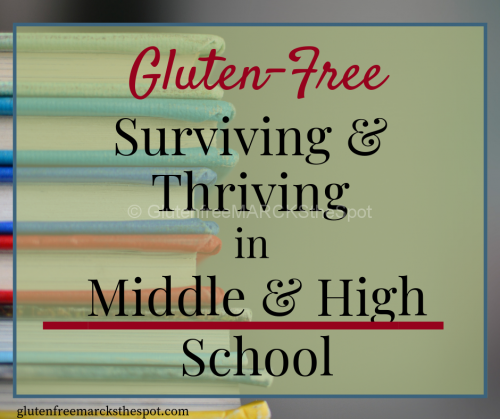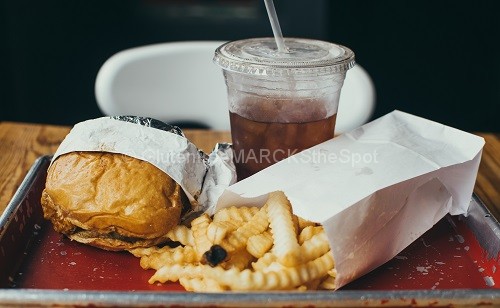Do you have a gluten-free teen in Middle School or High School?
It’s amazing to watch our children enter middle and high school. What pride we hold for them as they grow and develop.
These special years bring about a whole new level of understanding gluten-free living, and what the dangers of not knowing can bring.
Keeping all informed
Like every stage of education, it’s important to inform the school of your child’s gluten-free status and keep the lines of communication open. School food and medical policies have changed a lot over the years due to the rising number of food allergies in today’s society.
Complete all forms needed to ensure your child has a safe environment while at school. Depending on your situation, your teen may need an Individual Health Care Plan or a 504 plan. (You can find more information about that here.)

More independent gluten-free teens
During this time, your children are growing and becoming more independent.
Teens should understand what is safe for them to consume to keep themselves healthy and strong. They should be able to choose safe foods and pack their own lunches.
Reading labels is a needed skill. Most gluten-free teens don’t want to eat a forbidden food then end up missing school, sports, or other activities. Eating a food they are allergic to can cause multiple days of absences, which is not beneficial.
Teens can also learn to be mindful of what they are eating, and how they feel afterwards. Often, other allergies or intolerances may surface. By paying attention to how their body responds to what they have eaten, can help determine which food may be the culprit.
Lunch at school
A gluten-free lunch should be packed by your teen. This is a good step in responsibility and helps them learn about choosing healthier foods. You’ll find that they pack foods they will eat, meaning less food waste.
Hopefully, at this age, your children will also start to realize how eating healthier choices gives them better energy, stamina and strength to get through the school day. This is especially important if they are staying after school for sports or activities, or heading to work after school.
Check with the School Food (Cafeteria) Manager if your child wants to order lunch in the cafeteria. You can find what, and when gluten-free options are available. More importantly, discuss how the food is prepared, making sure that cross-contamination issues are addressed.
Always choose the path that will keep your child healthy throughout the school day. There’s nothing worse than having a reaction while at school.
![]()
Cooking in school
Starting in middle school students may be cooking in their home-economics or FACS (Family & Consumer Science) classes. Prior to starting the class, set up a time to speak with the teacher. Together plan allergy-safe dishes to go along with the class recipes.
Our teachers were extremely helpful in this regard. Often we sent in gluten-free substitutions for the teacher’s recipe. My children were not left out and made everything their friends cooked in class using an allergy-safe version.
Cross-contamination can be a big issue when cooking in class, so make sure this is a topic you discuss with your child’s teacher. Using gluten-filled ingredients, trying taste tests or having flour in the air may not be a good bet for your gluten-free child.
The teachers were very thankful we explained this topic. They didn’t have an understanding of gluten allergies or cross-contamination. After our meeting, they even purchased new kitchen items to be used by the gluten-free students.
Make sure you speak up and share when allergy attacks happen so this can be addressed. Teens can have great experiences learning about cooking with their food allergies, all handled in a safe manner.

Dangerous times . . .
Alcohol and drugs are a topic of discussion that needs to happen with your gluten-free teens (actually this should now be starting at earlier ages). It’s important to keep the lines of communication opened to be aware of the dangers alcohol and drugs can have when combined with food allergies.
Gluten is hidden within many drugs and alcoholic drinks. Your kids need to be aware of this.
Beer is made from wheat and barley, NOT something that a Celiac or gluten-free child should be “trying”. Many other alcoholic beverages also contain gluten.
Make sure your child knows this interesting fact before they head out to a party with friends.
Many pills and drugs contain gluten as well. The rise of stolen prescriptions and inhaling over-the-counter drugs could create dangerous outcomes for a gluten-free teen.
Kissing can also be a somewhat tricky situation. Talk to your teens about kissing others who just ate gluten-filled food.
These are the years teens may test the waters. Educating your child on what is safe and unsafe, and all the hidden dangers are of utmost importance.
Eating Out with friends
As your gluten-free teens grow and mature, continuously share information to help them become secure in making good choices when out on their own.
Ordering pizza with friends or grabbing take-out can cause some stress. Research places in your area for safe gluten-free places to go to with friends. Not all friends may be on board with this so talk with your child about how to handle this situation.
Talk to your teen about not making it all about the food. Your child can grab something to eat prior or bring something safe along, if acceptable. Offer gluten-free safe options all teens will enjoy at your home to hang together there.
When hanging out at friends’ houses, have your teen bring snacks so he is not left out when others are eating.

Your healthy gluten-free teen
All in all, continue to talk about food safety with your teens. Have them help prepare meals, learn recipes and read labels with you while you’re shopping.
Keep communication open as they grow and nourish their bodies with safe food choices to follow a healthy, fit road to their future.
Every step of the way, food allergies can cause some difficulties.
Handled well, they can be seamless and all can have a great experience throughout these important gluten-free middle school and high school years.














